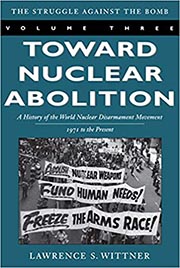Toward Nuclear Abolition: A History of the World Nuclear Disarmament Movement, 1971 to the Present
by Lawrence S. Wittner
Reviewed July 19, 2005
 Toward Nuclear Abolition: A History of the World Disarmament Movement, 1971 to Present completes Lawrence Wittner's ambitious and valuable trilogy on the history of the world nuclear disarmament movement. The two previous parts of the trilogy are One World or None (1993), which looks at the movement through 1953, and Resisting the Bomb (1997), which covers the period 1954 to 1970. In this volume, Wittner argues that that it was the citizens' movement that helped move the world back from the nuclear brink and ended the Cold War. Although this may seem to be a bold claim to some, his thorough documentation does provide evidence that their influence was greatly underestimated by many.
Toward Nuclear Abolition: A History of the World Disarmament Movement, 1971 to Present completes Lawrence Wittner's ambitious and valuable trilogy on the history of the world nuclear disarmament movement. The two previous parts of the trilogy are One World or None (1993), which looks at the movement through 1953, and Resisting the Bomb (1997), which covers the period 1954 to 1970. In this volume, Wittner argues that that it was the citizens' movement that helped move the world back from the nuclear brink and ended the Cold War. Although this may seem to be a bold claim to some, his thorough documentation does provide evidence that their influence was greatly underestimated by many.
He chronicles the movement's ebb and flow through the decades, from the heights during the intense build-ups of the Reagan era, to the lows as the Cold War ended, leaving the movement without the same focus it had previously. Wittner explores the pressures from the nuclear disarmament movement on various administrations on both sides of the Cold War.
One of the more interesting aspects of the book is the nuclear saga in the Pacific region, where New Zealanders and Pacific islanders tenaciously and boldly challenged nuclear testing and began establishing nuclear-free zones.
Wittner also chronicles the rise of such groups like Physicians for Social Responsibility, the Union of Concerned Scientists, SANE, and others. This book provides future readers the ability to explore an often forgotten nuclear arms movement, or as Wittner wrote, "is like telling the story of civil rights legislation without referring to the civil rights movement". The story of this movement has had its first telling, in an excellent manner. Available at amazon.com